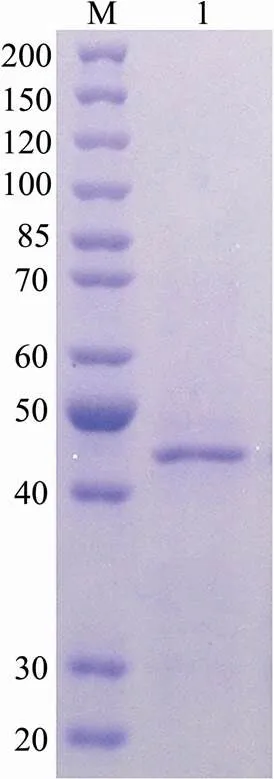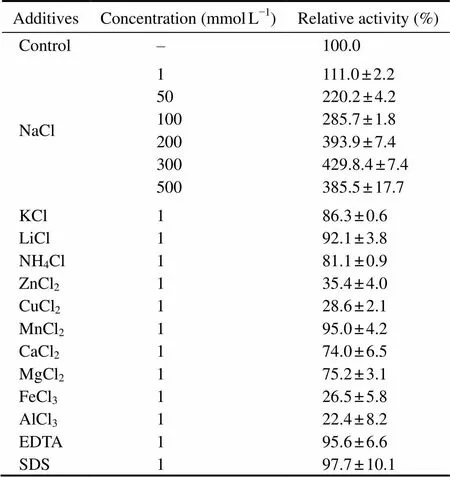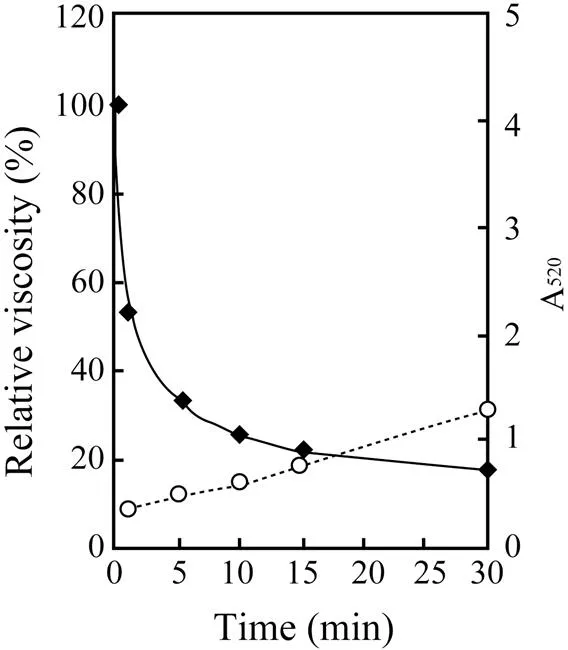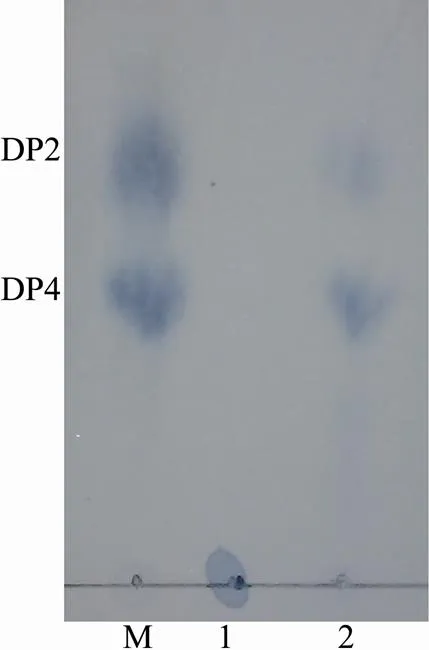Cloning and Characterization of a New κ-Carrageenase Gene from Marine Bacterium Pseudoalteromonas sp.QY203
XU Xiaoyan, LI Shangyong, YANG Xuemei, YU Wengong, and HAN Feng, *
Cloning and Characterization of a New κ-Carrageenase Gene from Marine Bacteriumsp.QY203
XU Xiaoyan1), 2), LI Shangyong1), YANG Xuemei1), YU Wengong1), and HAN Feng1), *
1) Key Laboratory of Marine Drugs of Chinese Ministry of Education;Provincial Key Laboratoryof Glycoscience & Glyco- technology of Shandong; School of Medicine and Pharmacy, Ocean University of China, Qingdao 266003, P. R. China 2) Department of Stomatology,The Affiliated Hospital of Qingdao University, Qingdao 266003, P. R. China
κ-carrageenan oligosaccharides exhibit various biological activities. Enzymatic degradation by κ-carrageenase is safe and controllable. Therefore, κ-carrageenases have captured more and more attentions. In this study, a κ-carrageenase encoding gene,, was cloned fromsp. QY203 with degenerate and inverse PCR. It comprised an ORF of 1194bp in length, encoding a protein with 397 amino acid residues. CgkX is a new member of glycoside hydrolase family 16. The deduced amino acid sequence shared a high similarity with CgkX ofκ-carrageenase; however, the recombinant CgkX showed different biochemical characteristics. The recombinant enzyme was most active at pH 7.0 and 55℃ in the presence of 300mmolL−1NaCl. It was stable in a broad range of acidity ranging from pH 3.0 to pH 10.0 when temperature was below 40℃. More than 80% of its activity was maintained after being incubated at pH 3.6–10.0 and 4℃ for 24h. CgkX retained more than 90% of activity after being incubated at 40℃ for 1h. EDTA and SDS (1mmolL−1) did not inhibit its activity. CgkX hydrolyzed κ-carrageenan into disaccharide and tetrasaccharide as an endo-cleaver.All these characteristics demonstrated that CgkXis applicable to both κ-carrageenan oligosaccharideproductionand κ-carrageenase structure-function research.
κ-carrageenase; cloning; expression; characterization; Pseudoalteromonas
1 Introduction
Carrageenans are linear and sulfated galactans synthesized by many red seaweeds, and they share a backbone of D-galactose with alternating α-1,3 and β-1, 4 linkages (Liu., 2011). These polysaccharides are mainly classified into κ-, ι- and λ-carrageenans based on the number and position of sulfate substitutions, as well as the presence of a 3, 6-anhydro-bridge. κ-carrageenan oligosaccharides exhibit various biological activities, such as anti- viral and anti-tumor activities (Mou, 2003), and anti-inflammation and immunoregulation activities (Yuan., 2006).
The κ-carrageenase (EC 3.2.1.83) is classified into family 16 of glycoside hydrolases. It cleaves the internal β-1, 4 linkages of κ-carrageenans, yielding sulfated oligosaccharides (Li, 2013). Several κ-carrageenases have been purified from the lysate of bacteria in genera,,,and(Collén, 2009; Khambhaty, 2007; Potin, 1991; Toshiyoshi., 1999; Youssef, 2012). Recently, a marine bacterium,sp. QY203, was found to be able to secrete various carrageenases including a thermostable κ-carrageenase, CgkP (Li., 2013).
In this study, we cloned CgkP encoding gene fromsp. QY203, expressed it in, and purified the recombinant protein. The recombinant CgkX was characterized as a new κ-carrageenase. The recombinant protein promised for industrial applications as it was stable in a broad range of acidity.
2 Materials and Methods
2.1 Bacterial Strains, Media and Culture Conditions
sp. QY203 was isolated from the surface of decayed red algaecollected from the coast of Qingdao, China, and was preserved in our laboratory. It was cultured at 25℃ in 2216E medium.DH5α (Gibco BRL) and BL21(DE3) (Novagen) were grown at 37℃ in LB broth, or on LB agar supplemented with 30 μg kanamycin per mL if necessary.
2.2 Cloning and Sequence Analysis of a κ-Carrageenase-Encoding Gene
Genomic DNA of QY203 was isolated with Genomic DNA Extraction Kit (TaKaRa, China) and used as the template of degenerate PCR amplification. Degenerate primers (PcgkX-F1: 5’-AAYTTYCARACNGARAAYTA YGG-3’, PcgkX-R1: 5’-TCNACYTCCATNGANGTNG G-3’) were designed according to the conservative regions of κ-carrageenases. A PCR product (0.69kb) was obtained and sequenced. Inverse PCR was used to amplify the flanking sequences with two primer pairs (PcgkX-F2: 5’-TGTGTAAGACATGATCAGAT-3’, PcgkX- R2: 5’-GATCACTTGGTATGTTGATG-3’; and PcgkX-F3: 5’-TGGGTAATTTGCAACTTGCT-3’, PcgkX-R3: 5’-AT ACTGGCATCGTCAAATGA-3’). The PCR product was purified, sequenced and assembled with the initial fragment to obtain the full-length κ-carrageenase gene,. The DNA sequence ofhas been deposited in GenBank under accession number JQ755419.
The putative open reading frame was identified with the DNATools program. The theoretical molecular weight and isoelectric point were calculated with the Compute pI/Mw tool (http://web.expasy.org/compute_pi). The signal peptide was predicted with SignalP 4.1 server (http:// www.cbs.dtu.dk/services/SignalP). Multiple sequence a- lignment of CgkX and other known κ-carrageenases was carried out with the ClustalX program.
2.3 Expression and Purification of Recombinant CgkX
To express, the primers (PcgkX-F4: 5’-GGAAT TCCATATGGCATCTATGCAACCTCCCA-3’, PcgkX-R4: 5’-CCGCTCGAGATTCACCGCAATGGTTAATT-3’) were designed to introduceI andI sites intoThe PCR product was gel-purified, digested withI andI, and ligated into plasmid pET-28a(+) that was digested withI andI ahead. The recombinant plasmid pET28-cgkX was transferred intoBL21 (DE3).
BL21 (DE3) harboring pET28-cgkX was cultured at 37℃ in LB supplemented with 30μg kanamycin per mL until OD6000.6. IPTG was then added to a final concentration of 0.1mmolL−1. After cultivation at 18℃ and 150rmin−1for additional 24h, bacterial cells were harvested by centrifuging at 4℃ and 10000×for 10min, resuspended in phosphate buffer (20mmolL−1, pH 7.5; 500mmolL−1NaCl) and ultrasonically disrupted. The lysate was centrifuged at 4℃ and 10000×for 30min with the supernatant loaded onto a HisTrap HP column (1mL, GE Healthcare). The recombinant protein was eluted with a linear gradient of imidazole (25–500mmolL−1) in phosphate buffer (20mmolL−1, pH 7.5; 500mmolL−1NaCl) with the active fractions stored at −20℃.
Protein concentration was measured with bicinchoninic acid (BCA) method with bovine serum albumin (BSA) as the standard.SDS-PAGE was performed to determine the purity and molecular weight of recombinant CgkX.
2.4 Assay of Recombinant CgkX Activity
Unless stated otherwise, 0.1mL of enzyme was mixed with 0.9mL of κ-carrageenan solution (2gL−1 in 100mmolL−1sodium phosphate buffer, pH 7.0) and incubated at 55℃ for 10min. The mixture was then heated at 100℃ for 10min. The released reducing sugar was quantitated with 3,5-dinitrosalicylic acid (DNS) method. One unit of κ-carrageenase activity was defined as the amount of enzyme required for releasing 1μmol of reducing sugar (measured as galactose) per minute under the above condition.
2.5 Biochemical Characterization of Recombinant CgkX
2.6 Analysis of Hydrolytic Mode
Recombinant CgkX was added to 50mL of κ-carra- geenan solution (5gL−1) to a final concentration of 0.1UmL−1. The mixture was incubated at 55℃ for up to 30min. An aliquot of hydrolysis product (0.5mL) was taken out at different times (1, 5, 10, 15 and 30min) to determine the viscosity with the method described previously (Kobayashi., 2012) and reducing sugar with DNS method.
2.7 Degrading Product Analysis of Recombinant CgkX
One milliliter of purified enzyme (3UmL−1) was mixed with 4mL of κ-carrageenan (2gL−1) and incubated at 40℃ for 48h. The end product of κ-carrageenase degrading reaction was analyzed using thin-layer chromatography (TLC) with n-butanol/acetic acid/water (2:1:1) as the solvent (Toshiyoshi., 1999).
3 Results and Discussion
3.1 Cloning and Sequence Analysis ofGene
A κ-carrageenase encoding gene,,was isolated fromsp. QY203. The ORF ofwas 1194bp in length. The deduced protein composed of 397 amino acid residues with a calculated molecular weight of 44267Da and an isoelectric point of pH 9.54. Recombinant CgkX had a signal peptide, Met1-Ala25. The calculated molecular weight and isoelectric point of mature CgkX were 41673Da and pH 9.51, respectively.
The κ-carrageenase CgkX belonged to the glycoside hydrolase family 16 (GH16). It was highly similar with GH16 κ-carrageenases from the bacteria, such as CgkA of(CAA50624, 96%), Cgk-K142 of(BAJ61957, 94%), κ- carrageenase ofsp. Bsw20308 (EKS 11233, 84%), and κ-carrageenase ofsp. LL1 (ADD92366, 78%). The deduced amino acid sequence of CgkX was found to be less homologous to other GH 16 κ-carrageenases from the bacteria in generaand(25%–35%).
3.2 Expression and Purification of Recombinant CgkX
1.1资料 选择从2016年3月~2017年11月在我院急诊输液室发生药物不良反应的患者117例,其中男性56例,女性61例,年龄11个月~74岁,平均(41.32±4.37)岁,不良反应发生时间为输液后2 min~55 h,其中<30 min者95例,占81.20%。所有患者均经停药及对症处置,11例症状严重者住院留观,均于次日出院,未发生严重不良反应事件。
The recombinant κ-carrageenase CgkX with a (His)6tag at its N-terminal was synthesized and secreted byBL21 (DE3) harboring pET28-cgkX. The recombinant enzyme was purified 45.3 folds to a specific activity of 17.9Umg−1. The overall yield was 65%. The purified enzyme aggregated into a single band with an apparent molecular weight of 44kDa on SDS-PAGE, which was in accordance with the calculated (Fig.1). The molecular weight and specific activity of recombinant CgkX were different from CgkP purified from the lysate ofsp. QY203 (34kDa, 1121.7Umg−1) (Li, 2013), indicating that they were different enzymes.

Fig.1 SDS-PAGE of recombinant CgkX. M, molecular weight marker; 1, purified CgkX. The gel was stained with Coomassie Brilliant Blue.
3.3 Biochemical Characterization of Recombinant CgkX
The effect of acidity on the activity and stability of recombinant κ-carrageenase CgkX were shown in Figs.2a and b. Maximum activity of the enzyme was observed at pH 7.0 in Na2HPO4-citric acid buffer. Recombinant CgkX was stable in a broad range of acidity from pH 3.0 to pH 10.0. More than 80% of the activity was maintained after being incubated at pH 3.6–10.0 and 4℃ for 24h. The optimum pH value of most reported κ-carrageenases ranges from 6.0 to 8.0 (Sun., 2010; Liu, 2011; Kobayashi., 2012; Yao, 2013; Liu, 2013; Li., 2013); however, these enzymes were not stable when pH was lower than 5.0 or higher than 9.0. The κ- carrageenase CgkP fromsp. QY203 retained approximately 40% and 55% of the activity after being incubated at 4℃ and pH 5.0 and 10.0, respectively, for 6h (Li., 2013). Such treatment retained only 35% of the activity of κ-carrageenase fromLL1 (Liu, 2011). The κ-carrageenase CgkZ fromsp. ZM-2 lost almost all activity after being incubated at pH 10.0 and 20℃ for 2h (Liu, 2013). A comparison among these findings demonstrated that κ-carra- geenase CgkX from QY203 was more stable in a broad pH range than those reported previously.
Recombinant CgkX was most active at 55℃ (Fig.2c), the same as the κ-carrageenases fromsp. AJ5-3 (Ma., 2010),LL1 (Liu., 2011) andJAM-K142 (Kobayashi, 2012). The optimal temperature of the enzymes reported previously is below 40℃ (Araki., 1999; Khambhaty., 2007; Sun., 2010; Yao, 2013; Liu, 2013); however, recombinant CgkX was found to be stable when the temperature ranged from 0 to 40℃, as it remained more than 90% of activity after being incubated at 40℃ for 1h (Fig.2d). The κ-carrageenases fromLL1,ATCC 43555 andwere stable only when temperature was below 30℃ (Liu., 2011). CgkZ fromsp. ZM-2 lost approximately 50% of activity when it was incubated at 40℃ for 1h (Liu., 2013). Recombinant CgkX was more thermostable than most of the previously reported κ-carrageenases.

Fig.2 Effect of acidity and temperature on the activity and stability of recombinant CgkX. (a) The optimal pH value. Buffers (100mmolL−1) were Na2HPO4-citric acid (¿), Na2HPO4-NaH2PO4 (△), Tris-HCl () and Gly-NaOH (¯). (b) The acidity stability. The same buffers were used as for acidity. (c) The optimal temperature. (d) The thermostability.
Recombinant CgkX activity was measured in the presence of various chemicals under standard assay conditions. Metal ion Mn2+and Li+had little effect on the enzyme activity. Ions such as K+, NH4+, Ca2+, Mg2+slightly inhibited the enzyme activity (13.7%–26.0%), whereas Zn2+, Cu2+, Fe3+and Al3+(64.6%–77.6%) strongly inhibited the activity. Recombinant CgkX was active in the absence of NaCl; however, its activity was enhanced markedly by NaCl (1–500mmolL−1). The optimum NaCl concentration for recombinant CgkX was 300mmolL−1, which was higher than that of κ-carrageenases fromsp. AJ5-13 (50mmolL−1),(150mmolL−1) (Michel., 2006) andsp. ZM-2 (100mmolL−1) (Liu., 2013). The presence of NaCl inhibited the activity of κ-carrageenases fromLL1 (Liu., 2011) andsp. HC4 (Sun., 2010). EDTA had little effect on the activity of recombinant CgkX, suggesting that metal ions may not be involved in the catalytic site of recombinant CgkX. The activity of recombinant CgkX was not inhibited by SDS (Table 1).

Table 1 Effect of chemicalson κ-carrageenase activity ofrecombinant CgkX
Notes: Activity without addition of chemicals was defined as 100%. Data were shown as means±SD (=5).
3.4 Analysis of Hydrolytic Mode
To determine the hydrolytic mode of recombinant CgkX, the viscosity and reducing sugar of κ-carrageenan solution were measured after recombinant CgkX was added. The viscosity decreased sharply in first 5min, but slowly in following 25min. However, the amount of reducing sugar (A520) increased steadily through the whole process (30min) (Fig.3). These findings suggested that recombinant CgkX degraded κ-carrageenans as an endo- cleaver.

Fig.3 Viscosity and reducing sugar of κ-carrageenan solution during enzymatic degradation. ¿, relative viscosity; , the absorbance at 520nm.
3.5 Analysis of Degradation Product
The end degradation product of κ-carrageenan by recombinant CgkX was analyzed using TLC. As showed in Fig.4, the main end products were disaccharide and tetrasaccharide. κ-Carrageenases fromsp. HC4 also degrade κ-carrageenan into disaccharide and tetrasaccharide (Sun., 2010) while κ-carrageenases fromATCC43555,sp. ZM-2 andN5-2 degrade κ-carrageenan into oligosaccharides with DP 2-10 (Barbeyrona., 1994; Liu., 2013; Yao., 2013), and κ-carra- geenase fromLL1 produces tetrasaccharide as the main product (Liu., 2011). Although GH16 κ-carrageenases from the bacteriashowed high similarity in amino acid sequence, they display different biochemical characteristics and yield degradation products, which make them suitable for κ-car- rageenase structure-function research.

Fig.4 TLC analysis of recombinant CgkX degradation product. M, the mixture of κ-neocarratetraose and κ-neo- carrabiose sulfate; 1, κ-carrageenan with inactivated recombinant CgkX; 2, end products of κ-carrageenan hydrolyzed by recombinant CgkX.
Acknowledgements
This work was supported by the National High-Tech R&D Program (No. 2011AA090703), the National Natural Science Foundation of China (No. 31070712), and the Special Fund for Marine Scientific Research in the Public Interest (Nos. 201105027 and 201005024).
Araki, T., Higshimoto, Y., and Morishita, T., 1999. Purification and characterization of κ-carrageenase from a marine bacte- rium,sp. CA-1004., 65: 937-942.
Barbeyrona, T.,Henrissatb, B., andKloareg, B., 1994. The gene encoding the kappa-carrageenase ofis related to β-1,3-1,4-glucanases., 139: 105- 109.
Collén, P. N., Lemoine, M., Daniellou, R., Guégan, J. P., Paoletti, S., and Helbert, W., 2009. Enzymatic degradation of κ-carrageenan in aqueous solution.,10:1757-1767.
Khambhaty, Y., Mody, K., and Jha, B., 2007. Purification and characterization of κ-carrageenase from a novel γ-proteobac- terium,(MTCC 5261) syn.comb. Nov. Biotechnol., 12: 668-675.
Kobayashi, T., Uchimura, K., Koide, O., Deguchi, S., and Horikoshi, K., 2012. Genetic and biochemical characterization of thealkaline κ-carra- geenase., 76: 506- 511.
Li, S. Y., Jia, P. P., Wang, L. N., Yu, W. G., and Han, F., 2013. Purification and characterization of a new thermostable κ-carrageenase from the marine bacteriumsp. QY203., 12: 155-159.
Liu, G. L., Li, Y., Chi, Z., and Chi, Z. M., 2011. Purification and characterization of κ-carrageenase from the marine bacteriumfor hydrolysis of κ- carrageenan., 46: 265-271.
Liu, Z. M., Li, G. Y., Mo, Z. L., and Mou, H. J., 2013. Molecular cloning, characterization, and heterologous expression of a new κ-carrageenase gene from marine bacteriumsp. ZM-2.,97: 10057- 10067.
Potin, P., Sanseau, A., Le, G. Y., Rochas, C., and Kloareg, B., 1991.Purification and characterization of a new kappa-car- rageenase from a marine-like bacterium.,201: 241-247.
Ma, Y.X., Dong, S.L., Jiang, X.L., Li, J., and Mou, H.J., 2010. Purification and characterization of kappa-carrageenase from marine bacterium mutant strainsp. AJ5-13 and its degraded products., 34: 661-678.
Michel, G., Nyval, C.P., Barbeyron, T., Czjzek, M., and Helbert, W., 2006. Bioconversion of red seaweed galactans: A focus on bacterial agarases and carrageenases., 71: 23-33.
Mou, H., Jiang, X. L., and Guan, H. S., 2003. A κ-carrageenan derived oligosaccharide prepared by enzymatic degradation containing anti-tumor activity., 15:297-303.
Toshiyoshi, A., Yoshifumi, H., and Tatsuo, M., 1999. Purification and characterization of kappa-carrageenase from a marine bacteriumsp. CA-1004.,65:937-942.
Sun, F. X., Ma, Y. X., Wang, Y., and Liu, Q., 2010. Purification and characterization of novel κ-carrageenase from marinesp. HC4., 28: 1139-1145.
Yao, Z., Wang, F. F., Gao, Z., Jin, L. M., and Wu, H. G., 2013. Characterization of a κ-carrageenase from marine cellulo- phaga lytica strain N5-2 and analysis of its degradation products., 14: 24592- 24602.
Youssef, A. S., Beltagy, E. A., El-Shenawy, M. A., and El-As- sar, S. A., 2012. Production of k-carrageenase byisolated from Egyptian Mediterranean coast., 6: 6618- 6628.
Yuan, H., Song, J., Li, X., Li, N., and Dai, J., 2006. Immunomodulation and antitumor activity ofκ-carrageenan oligosaccharides.,243:228-234.
(Edited by Qiu Yantao)
DOI 10.1007/s11802-015-2652-7
ISSN 1672-5182, 2015 14 (6): 1082-1086
© Ocean University of China, Science Press and Spring-Verlag Berlin Heidelberg 2015
(April 22, 2014; revised May 28, 2014; accepted September 10, 2015)
* Corresponding author. Tel: 0086-532-82032067 E-mail: fhan@ouc.edu.cn
 Journal of Ocean University of China2015年6期
Journal of Ocean University of China2015年6期
- Journal of Ocean University of China的其它文章
- Tidal Characteristics in the Wenzhou Offshore Waters and Changes Resulting from the Wenzhou Shoal Reclamation Project
- An Improved Lower Order Method of Modal Parameter Estimation for Offshore Structures Using Reconstructed Signals
- Establishment and Characterization of a New Marine Fish Cell Line from Ovary of Barfin Flounder (Verasper moseri)
- Characterization and Expression Analysis of a Complement Component Gene in Sea Cucumber (Apostichopus japonicus)
- Mapping Toll-Like Receptor Signaling Pathway Genes of Zhikong Scallop (Chlamys farreri) with FISH
- Lysobacter hymeniacidonis sp. nov., Isolated from a Crude Oil-Contaminated Marine Sponge
